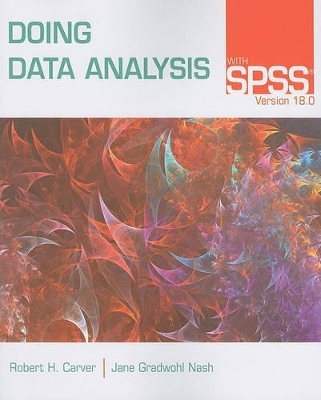
Doing Data Analysis with SPSS®
Duxbury Press
978-0-8400-4916-2 (ISBN)
- Titel ist leider vergriffen;
keine Neuauflage - Artikel merken
Robert Carver is Professor of Business Administration at Stonehill College in Easton, Massachusetts. He teaches courses in business statistics, information systems, business and society, as well as the Department's Senior Honors Research Seminar. He is author of two statistics texts for Duxbury Press, and his research has appeared in THE JOURNAL OF STATISTICS EDUCATION, THE JOURNAL OF BUSINESS ETHICS, THE JOURNAL OF CONSUMER MARKETING, THE PUBLIC PRODUCTIVITY REVIEW, PS: POLITICAL SCIENCE AND POLITICS, PUBLIUS, and THE PUBLIC ADMINISTRATION REVIEW. He earned his A.B. from Amherst College and his M.P.P. and Ph.D. from the University of Michigan. Jane Gradwohl Nash is Professor of Psychology at Stonehill College in Easton, Massachusetts. She teaches General Psychology, Developmental Psychology, Cognitive Psychology, and Introduction to Statistics. Prior to arriving at Stonehill, Professor Nash taught at Quinnipiac College in Connecticut and completed a post-doctoral fellowship at Carnegie Mellon University, where she conducted research concerning cognitive processing in writing. Her current research is in the areas of knowledge change and judgment and decision-making. Her research has appeared in THE JOURNAL OF EDUCATIONAL PSYCHOLOGY, ORGANIZATIONAL BEHAVIOR AND HUMAN DECISION PROCESSES, HEADACHE, JOURNAL OF CHEMICAL EDUCATION, RESEARCH IN THE TEACHING OF ENGLISH, and WRITTEN COMMUNICATION. Professor Nash received her B.A. in Psychology and Spanish from Grinnell College. She received her M.S. and Ph.D. in Experimental Psychology with an emphasis in Cognitive Psychology at Ohio University.
SESSION I. A FIRST LOOK AT SPSS 18.0.
Objectives. Launching SPSS. Entering Data into the Data Editor. Saving a Data File. Creating a Bar Chart. Saving an Output File. Getting Help. Printing in SPSS.
Quitting SPSS.
SESSION II. TABLES AND GRAPHS FOR ONE VARIABLE.
Objectives. Opening a Data File. Exploring the Data. Creating a Histogram. Frequency Distributions. Another Bar Chart. Printing Session Output. Moving On.
SESSION III. TABLES AND GRAPHS FOR TWO VARIABLES.
Objectives. Cross-Tabulating Data. Editing a Recent Dialog. More on Bar Charts. Comparing Two Distributions. Scatterplots to Detect Relationships. Moving On.
SESSION IV. ONE-VARIABLE DESCRIPTIVE STATISTICS.
Objectives. Computing One Summary Measure for a Variable. Computing Additional Summary Measures. A Box-and-Whiskers Plot. Standardizing a Variable. Moving On.
SESSION V. TWO-VARIABLE DESCRIPTIVE STATISTICS.
Objectives. Comparing Dispersion with the Coefficient of Variation. Descriptive Measures for Subsamples. Measures of Association: Covariance and Correlation. Moving On.
SESSION VI. ELEMENTARY PROBABILITY.
Objectives. Simulation. A Classical Example. Observed Relative Frequency as Probability. Handling Alphanumeric Data. Moving On.
SESSION VII. DISCRETE PROBABILITY DISTRIBUTIONS.
Objectives. An Empirical Discrete Distribution. Graphing a Distribution. A Theoretical Distribution: The Binomial. Another Theoretical Distribution: The Poisson. Moving On.
SESSION VIII. NORMAL DENSITY FUNCTIONS.
Objectives. Continuous Random Variables. Generating Normal Distributions. Finding Areas under a Normal Curve. Normal Curves as Models. Moving On.
SESSION IX. SAMPLING DISTRIBUTIONS.
Objectives. What Is a Sampling Distribution? Sampling from a Normal Population. Central Limit Theorem. Sampling Distribution of the Proportion. Moving On.
SESSION X. CONFIDENCE INTERVALS
Objectives. The Concept of a Confidence Interval. Effect of Confidence Coefficient. Large Samples from a Non-normal (Known) Population. Dealing with Real Data. Small Samples from a Normal Population. Moving On.
SESSION XI. ONE-SAMPLE HYPOTHESIS TESTS.
Objectives. The Logic of Hypothesis Testing. An Artificial Example. A More Realistic Case: We Don't Know Mu or Sigma. A Small-Sample Example. Moving On.
SESSION XII. TWO-SAMPLE HYPOTHESIS TESTS.
Objectives. Working with Two Samples. Paired vs. Independent Samples. Moving On.
SESSION XIII. ANALYSIS OF VARIANCE (I).
Objectives. Comparing Three or More Means. One-Factor Independent Measures ANOVA. Where Are the Differences? One-Factor Repeated Measures ANOVA. Where Are the Differences? Moving On.
SESSION XIV. ANALYSIS OF VARIANCE (II).
Objectives. Two-Factor Independent Measures ANOVA. Another Example. One Last Note. Moving On.
SESSION XV. LINEAR REGRESSION (I).
Objectives. Linear Relationships. Another Example. Statistical Inferences in Linear Regression. An Example of a Questionable Relationship. An Estimation Application. A Classic Example. Moving On.
SESSION XVI. LINEAR REGRESSION (II).
Objectives. Assumptions for Least Squares Regression. Examining Residuals to Check Assumptions. A Time Series Example. Issues in Forecasting and Prediction. A Caveat about Mindless" Regression. Moving On.
SESSION XVII. MULTIPLE REGRESSION.
Objectives. Going Beyond a Single Explanatory Variable. Significance Testing and Goodness of Fit. Residual Analysis. Adding More Variables. Another Example. Working with Qualitative Variables. A New Concern. Moving On.
SESSION XVIII. NONLINEAR MODELS.
Objectives. When Relationships Are Not Linear. A Simple Example. Some Common Transformations. Another Quadratic Model. A Log-Linear Model. Adding More Variables. Moving On.
SESSION XIX. BASIC FORECASTING TECHNIQUES.
Objectives. Detecting Patterns over Time. Some Illustrative Examples. Forecasting Using Moving Averages. Forecasting Using Trend Analysis. Another Example. Moving On.
SESSION XX. CHI-SQUARE TESTS.
Objectives. Qualitative vs. Quantitative Data. Chi-Square Goodness-of-Fit Test. Chi-Square Test of Independence. Another Example. Moving On.
SESSION XXI. NONPARAMETRIC TESTS.
Objectives. Nonparametric Methods. Mann-Whitney U Test. Wilcoxon Signed Ranks Test. Kruskal-Wallis H Test. Spearman’s Rank Order Correlation. Moving On.
SESSION XXII. TOOLS FOR QUALITY.
Objectives. Processes and Variation. Charting a Process Mean. Charting a Process Range. Another Way to Organize Data. Charting a Process Proportion. Pareto Charts. Moving On.
Appendix A. Dataset Descriptions.
Appendix B. Working with Files.
Objectives.
Data Files.
Viewer Document Files.
Converting Other Data Files into SPSS Data Files.
Index."
| Sprache | englisch |
|---|---|
| Maße | 186 x 232 mm |
| Gewicht | 613 g |
| Themenwelt | Mathematik / Informatik ► Mathematik ► Computerprogramme / Computeralgebra |
| ISBN-10 | 0-8400-4916-1 / 0840049161 |
| ISBN-13 | 978-0-8400-4916-2 / 9780840049162 |
| Zustand | Neuware |
| Haben Sie eine Frage zum Produkt? |